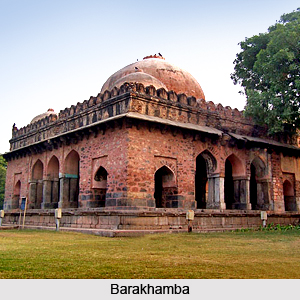 Barakhamba, situated in Delhi at Nizamuddin heritage area, is an ancient tomb belonging to the Lodi period. Also known as Barakhamba Monument, it was constructed in 14th century. The name of the monument, Barakhamba, literally means twelve pillars in Hindi and Urdu languages. This name has also been used for a modern metro road, called Barakhamba road, located at the heart of the city in Connaught Place. The tomb belongs to a high nobleman, the exact identity of whom is not known. Barakhamba is presently under restoration.
Barakhamba, situated in Delhi at Nizamuddin heritage area, is an ancient tomb belonging to the Lodi period. Also known as Barakhamba Monument, it was constructed in 14th century. The name of the monument, Barakhamba, literally means twelve pillars in Hindi and Urdu languages. This name has also been used for a modern metro road, called Barakhamba road, located at the heart of the city in Connaught Place. The tomb belongs to a high nobleman, the exact identity of whom is not known. Barakhamba is presently under restoration.
Architecture of Barakhamba
There are twelve pillars in the tomb, the architecture which has rendered it the name Barakhamba. On each face of the tomb, three arched opening can be witnessed. Around the central chamber there is a passage or verandah having four dome apartments located at each corner. Barakhamba is set amidst an open park and is easily accessible to the tourists and visitors. Researches have predicted that there possibly was a tomb chamber having arcades around it in this twelve pillared square monument and it was planned to be the Chausath Khamba. Regarding the twelve pillars of Barakhamba it has been inferred that mystical figures and motifs were a speciality of the Mughals which can be prominently witnessed in the Mughal monuments scattered throughout Delhi. Figure 7 and 12 especially received special significance in Mughal architecture which are believed to possess mystical association with real time events like 12 signs of the zodiac, 12 apostles, 12 months, 12 hours in the day and 12 in the night, 12 kinds of men and women, 12 branched candlesticks and 12 tribes. Thus twelve pillared buildings were common during ancient and medieval periods, and Barakhamba is a prominent one among them.
Restoration of Barakhamba
Barakhamba had suffered much neglect and was occupied by squatters for a long period of time. It was also vandalized by the occupants with graffiti on the walls. However lately the monument was freed from the illegal occupants and efforts were made to restore its original glory. Plans have also been made to beautify the park and garden around the monument. Archaeological Survey of India has begun working on the removal of scars and stains on the walls of the tomb as the first step of restoration. For this, chemical treatment is being done by using a special paste on the monument known as `multani mitti` pack for erasing the marks and refurbishing its original beauty. The second step of restoration work includes structural works on the monument. Barakhamba is enlisted amongst 46 monuments of Delhi which are under restoration.



















